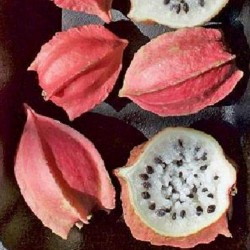Menu
-
MenuInapoi
- Home
-
Categorii
-
-
Categorii
-
Semințe de legume
-
Soiuri după țară
- Soiuri din Armenia
- Soiuri din BiH
- Soiuri din Croația
- Soiuri din Franța
- Varieties from Germany
- Varieties from Greece
- Varieties from Hungary
- Soiuri din India
- Varieties from Italy
- Soiuri din Japonia
- Soiuri din Macedonia de Nord
- Varieties from Peru
- Varieties from Russia
- Varieties from Serbia
- Soiuri din Slovenia
- Varieties from Spain
- Varieties from Thailand
- Soiuri din Turcia
- Varieties from USA
- Semințe de roșii
- Semințe de porumb
- Familia Dovleac
- Familia Bean
- Semințe de castraveți
- Seminte de ardei gras
- Familia morcovului
- Familia ceapa
- Semințe de salată verde
- Familia cartofilor
- Familia de varză
- Semințe de ridiche
- Familia sfeclei
- Semințe de pepene verde
- Semințe de pepene galben
- Semințe de conopidă
- Familia de floarea soarelui
-
Soiuri după țară
- Semințe de fructe
- Seminte de Chili Peppers
- Semințe de plante medicinale
- Semințe de plante cățărătoare
- Copaci - Arbust - Semințe
- Semințe de palmier
- Semințe de ierburi ornamentale
- Semințe de tutun
-
Semințe de legume
-
-
-
-
- PRODUSE NOI
- Crează un cont
- Livrare - Plata
- FAQ
Last Product Reviews
Out of the two seeds, one germinated and the other one was dead and floatin...
By
 Riikka H on 07/03/2024
Riikka H on 07/03/2024
Verified Purchase
Sunt 384 produse.
Se afiseaza 331-345 din 384 produs(e)

Planta rezistenta la frig si inghet
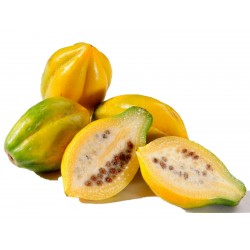
Semințe de papaya de munte...
Pret
3,00 €
(SKU: V 22 VP)
Seeds Gallery EU,
5/
5
<h2><strong>Semințe de papaya de munte (Carica pubescens) </strong></h2>
<h2><span style="color: #ff0000;"><strong>Preț pentru pachetul de 5 semințe. </strong></span></h2>
<p>Papaya de munte (Vasconcellea pubescens) cunoscută și sub numele de mountain pawpaw, papayuelo, chamburo sau pur și simplu „papaya” este o specie din genul Vasconcellea, originară din Anzii din nord-vestul Americii de Sud, din sudul Columbiei până în centrul Chile, de obicei crescând la altitudini de 1.500-3.000 metri (4.900-9.800 ft).<br><br>Plantele femele produc cantități mari de fructe galbene care sunt utilizate în mod tradițional pentru prepararea băuturilor și, de asemenea, fierte și mâncate.<br><br>Vasconcellea pubescens este un arbust pachycaul veșnic verde sau un copac mic care crește până la 10 metri înălțime.<br><br>Fructul are 6-15 cm lungime și 3-8 cm lățime, cu cinci coaste longitudinale largi de la bază la vârf; este verde, maturându-se de la galben la portocaliu. Pulpa de fructe este comestibilă, similară cu papaya, și este gătită de obicei ca legumă. De asemenea, se consumă crud.<br><br>De asemenea, a fost cunoscut sub numele de Carica pubescens.<br><br>Carica pubescens se potrivește cel mai bine climelor temperate calde, cărora le lipsesc extremele de căldură sau frig. </p>
V 22 VP

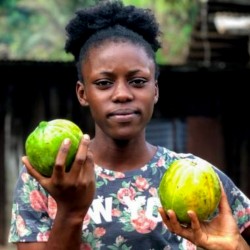
Seminte super rare de...
Pret
5,95 €
(SKU: V 22 GM)
Seeds Gallery EU,
5/
5
<h2 class=""><strong>Seminte super rare de Carica papaya Gabon Melon</strong></h2>
<h2><span style="color: #ff0000;"><strong>Preț pentru pachetul de 5 semințe.</strong></span></h2>
Un soi rar de papaya cultivat în Africa centrală. Plantele produc cantități mari de fructe globoase, aproape fructe globuloase, care au o aromă și o textură excelente.<br><br>Deoarece acest tip de papaya nu crește înalt (mini), este minunat pentru a crește în ghivece de flori. Fructează încă la un an după însămânțare.
V 22 GM (5 S)


Planta rezistenta la frig si inghet
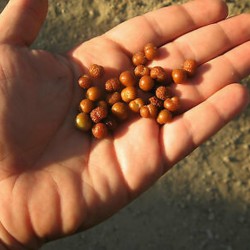
Stafidă de catifea, coacăz...
Pret de baza
1,75 €
-0,01 €
Pret
1,74 €
(SKU: V 90 GF)
Seeds Gallery EU,
5/
5
<h2 class=""><strong>Stafidă de catifea, coacăz sălbatic, semințe (Grewia flava)</strong></h2>
<h2><span style="color: #ff0000;"><strong>Prețul pentru un pachet de 10 semințe.</strong></span></h2>
Grewia flava este un arbust rezistent sau un copac mic, înalt de 2–4 m. Scoarța cenușie de pe ramurile tinere, care este de obicei acoperită cu fire groase, dar destul de scurte, tinde să devină gri închis și devine netedă cu cât copacul îmbătrânește; acest lucru se remarcă și pe tulpini. Frunzele verzui-cenușii sunt aranjate alternativ și sunt acoperite cu fire fine și par a fi o nuanță mai deschisă de verde pe partea inferioară a frunzelor. Vârful (vârful frunzelor) este rotunjit, în timp ce marginea este zimțată. Trei vene evidente de la baza frunzei sunt caracteristice acestui arbore; o tulpină de frunze lungă de 2 mm este de asemenea foarte vizibilă.<br><br>Florile apar în capete ramificate de la începutul verii până la mijlocul toamnei (octombrie-martie) și au un diametru de aproximativ 10–15 mm.<br><br>Fructul cu 2 lobi are un diametru de ± 8 mm, verde, devenind maroniu-roșcat când este copt. Alburnul pare a fi ușor, iar lemnul tare este maro, cu o textură fină.<br><br>Frunzele și fructele se bucură de animalele domestice, precum și de animalele sălbatice, cum ar fi Kudu și girafa și o mare varietate de păsări.<br><br>
<h3><strong>Utilizări</strong></h3>
Coaja de țuică a fost adesea folosită pentru fabricarea frânghiei. Fructele sunt încă folosite pentru a spori un fel de coniac sau „mampoer”. Fructul dulce îmbogățit cu vitamina C poate fi savurat și singur. În mod tradițional, terciul a fost preparat din fructele uscate după prelucrarea acestuia în făină. Lemnul este dur și cu granulație fină și este folosit pentru bețișoare. Vânătorii anteriori, precum comunitatea San, obișnuiau să-și facă arcurile și săgețile din ramurile acestei plante.<br><br>
<h3><strong>În creștere Grewia flava</strong></h3>
Această plantă va crește cel mai bine în sol bine drenat și într-o poziție plină de soare. Este destul de sigur să fie plantat lângă zone pavate în grădina domestică, văzând că nu are un sistem rădăcină agresiv. Datorită abundenței florilor, poate fi folosită cu succes ca punct focal în grădină.<br><br>Planta este destul de rezistentă și poate rezista la îngheț. Supra-udarea trebuie evitată atunci când planta este înființată.<br><br>Cea mai bună metodă de propagare este prin semințe. Selectați semințe proaspete, curățați-le și uscați-le într-o zonă umbrită bine ventilată. Înmuiați semințele în apă timp de cel puțin 24 de ore, apa inițială trebuie să fie apă fierbinte. Semănați semințele în tăvi pentru răsaduri și acoperiți-le cu o adâncime de aproximativ 5 mm; folosiți numai nisip de râu ca mediu de creștere. Așezați tăvile într-o zonă adăpostită caldă. Nu lăsați mediul de creștere să se usuce. Pentru a germina cu succes, trebuie menținut un nivel constant de umiditate. Germinarea semințelor este de obicei inconsistentă, s-a observat o rată de succes de aproximativ 50-70%. Răsadurile pot fi plantate în containere atunci când ajung la stadiul de 2 frunze.
V 90 GF

- -0,01 €

Acest produs este cel mai bine vândut produs
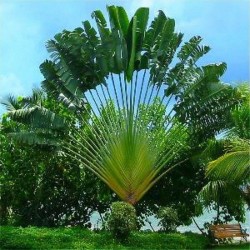
Travellers Palm Seeds
Pret
2,25 €
(SKU: PS 3)
Seeds Gallery EU,
5/
5
<h2 class=""><strong>Travellers Palm Seeds (Ravenala Madagascariensis)</strong></h2>
<h2><span style="color: #ff0000;"><strong>Price for Package of 3 seeds.</strong></span></h2>
<p>A fast-growing palm that forms huge leaves (up to 20ft long in its tropical home) arranged in a fan shape. However, in the UK it is easily kept as a beautiful indoor banana. For those of you who like to know such things the name comes from two unusual features - firstly the fan-shaped leaf structure tends to grow East-West and secondly when cut, the leaves provide refreshment to the (desperate!) thirsty traveler.</p>
<div></div>
<div>
<table cellspacing="0" cellpadding="0" border="1">
<tbody>
<tr>
<td colspan="2" width="100%" valign="top">
<p>Sowing Instructions</p>
</td>
</tr>
<tr>
<td valign="top" nowrap="nowrap">
<p>Propagation:</p>
</td>
<td valign="top">
<p>Seeds</p>
</td>
</tr>
<tr>
<td valign="top" nowrap="nowrap">
<p>Pretreat:</p>
</td>
<td valign="top">
<div>carefully remove the blue residue of the fruit</div>
<div>soak for 2 days in tepid water at 25-30 °C (77-86 °F)</div>
</td>
</tr>
<tr>
<td valign="top" nowrap="nowrap">
<p>Stratification:</p>
</td>
<td valign="top">
<p>0</p>
</td>
</tr>
<tr>
<td valign="top" nowrap="nowrap">
<p>Sowing Time:</p>
</td>
<td valign="top">
<p>all year round</p>
</td>
</tr>
<tr>
<td valign="top" nowrap="nowrap">
<p>Sowing Depth:</p>
</td>
<td valign="top">
<p>1 cm</p>
</td>
</tr>
<tr>
<td valign="top" nowrap="nowrap">
<p>Sowing Mix:</p>
</td>
<td valign="top">
<p>sow the seeds in 1 pot with soil, cover the pot to minimise evaporation</p>
</td>
</tr>
<tr>
<td valign="top" nowrap="nowrap">
<p>Germination temperature:</p>
</td>
<td valign="top">
<p>keep at 25-30 °C (77-86 °F)</p>
</td>
</tr>
<tr>
<td valign="top" nowrap="nowrap">
<p>Location:</p>
</td>
<td valign="top">
<p>bright + keep constantly moist not wet</p>
</td>
</tr>
<tr>
<td valign="top" nowrap="nowrap">
<p>Germination Time:</p>
</td>
<td valign="top">
<p>1 month to 1 year, very erratic</p>
</td>
</tr>
<tr>
<td valign="top" nowrap="nowrap">
<p>Watering:</p>
</td>
<td valign="top">
<p>Water regularly during the growing season</p>
</td>
</tr>
<tr>
<td valign="top" nowrap="nowrap">
<p> </p>
</td>
<td valign="top">
<p class=""><br />Copyright © 2012 Seeds Gallery - Saatgut Galerie - Galerija semena. All Rights Reserved.</p>
</td>
</tr>
</tbody>
</table>
</div>
<script src="//cdn.public.n1ed.com/G3OMDFLT/widgets.js"></script>
PS 3 (3 S)

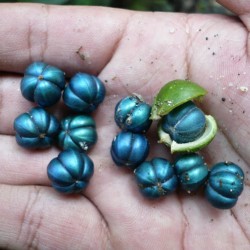
Semințe de Bastard Hogberry...
Pret
3,50 €
(SKU: V 55 MN)
Seeds Gallery EU,
5/
5
<h2 class=""><strong>Semințele Bastard Hogberry (Margaritaria nobilis)</strong></h2>
<h2><span style="color: #ff0000;"><strong>Preț pentru pachetul de 3 semințe.</strong></span></h2>
<strong>Decor pentru fiecare curte și grădină.</strong><br>Margaritaria nobilis este un copac de foioase cu coroana deschisă, globuloasă, de obicei înălțime de 8 - 16 metri. Bolul drept, cilindric, poate avea un diametru de 40 - 70cm. Planta poate fi uneori mai mult sau mai puțin verde.<br><br>Copacul este uneori recoltat din sălbăticie pentru utilizarea locală a lemnului său și este, de asemenea, potrivit pentru utilizarea în restabilirea pădurilor. Un copac ornamental și poate fi utilizat în proiecte de amenajare a teritoriului.<br><br>Margaritaria nobilis, cunoscută și sub denumirea de hogberry bastard, este o plantă roditoare care se găsește în Mexic, America Centrală, America de Sud și Indiile de Vest.<br><br>Fructul are o culoare albastră strălucitoare, care rezultă dintr-o structură de suprafață complexă care interferează cu undele luminoase.<br><br>Reușește în plin soare și în umbra pătată. Plantele pot tolera inundațiile sezoniere ale solului.<br>Un copac cu creștere rapidă până la moderat.<br>Plantele pot înflori și produce fructe aproape tot timpul anului.<br>O specie dioică, atât masculină, cât și feminină, trebuie cultivată dacă sunt necesare fructe și semințe.<br><br>De obicei, se poate aștepta o rată ridicată de germinare, semințele încolțind în câteva săptămâni. Când răsadurile au o înălțime de 4 - 5cm, puneți-le în recipiente individuale și ar trebui să fie gata de plantat aproximativ 4 - 5 luni mai târziu.
V 55 MN


Planta Ayurveda

Plantă medicinală sau condimentată
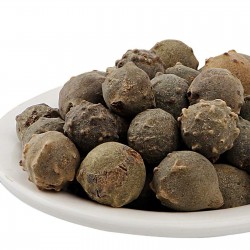
Semințe de stejar de Alep...
Pret
9,95 €
(SKU: T 90)
Seeds Gallery EU,
5/
5
<h2><strong>Semințe de stejar de Alep (Quercus infectoria)</strong></h2>
<h2><span style="color: #ff0000;"><strong>Preț pentru pachetul de 5 semințe.</strong></span></h2>
Quercus infectoria, stejarul Aleppo, este o specie de stejar, care poartă gale care au fost utilizate în mod tradițional de secole în Asia în mod medicinal. Manjakani este numele folosit în Malaezia pentru galele; acestea au fost folosite timp de secole la înmuierea pielii și la fabricarea vopselei și cernelii negre. În India, galele sunt numite majuphal printre multe alte nume.<br><br>Quercus infectoria este un copac mic originar din Grecia și Asia Mică, cu o înălțime de unu până la doi metri (patru până la șase picioare). Tulpinile sunt strâmbe, cu aspect tufiș, cu frunze netede și de un verde aprins purtate pe pețiole scurte de 3 până la 4 cm (1 până la 1,5 inci) lungime. Frunzele sunt mucronate direct, rotunjite, netede, inegale la bază și strălucitoare pe partea superioară.<br><br>Galele apar pe ramuri tinere ale arborelui Quercus infectoria atunci când viespile biliare înțepă stejarul și depun larvele lor. Reacția chimică determină o anomalie în stejar provocând formarea de bile tari. Ele sunt ondulate ca aspect.<br><br>Quercus infectoria poate fi folosit ca agent de îngroșare în tocănițe sau amestecat cu cereale pentru prepararea pâinii.<br><br>De asemenea, cunoscut sub numele de Majuphal în medicina tradițională indiană, manjakani a fost folosit ca pulbere dentară și în tratamentul durerii de dinți și a gingivitei.<br><br>Așa-numitul „tanin de Alep” este acidul tanic obținut din galele de stejar de Alep, care prezintă proprietăți chimice unice esențiale în prepararea solilor de aur (coloizi) folosiți ca markeri în imunocitochimie.<br><br>În zilele noastre, extractele de nuci sunt, de asemenea, utilizate pe scară largă în produse farmaceutice, aditivi alimentari și furaje, coloranți, cerneluri și metalurgie.<br><br>Majuphal Manjakani este una dintre cele mai puternice plante naturale din Ayurveda și este populară pentru beneficiile sale de strângere a țesuturilor la femei și este folosită ca plantă de protecție pentru sugari la scurt timp după naștere. Majuphal Manjakani este considerat cel mai bun remediu pentru prolapsul vaginal sau uterin, sângerările uterine anormale, scurgerile vaginale anormale și leucoreea.<br><br>Majuphal Manjakani pentru infecția urinară, Majuphal Manjakani ajută la ameliorarea infecțiilor tractului urinar. Proprietatea sa astringentă ajută la depășirea infecției în tractul urinar, pe lângă vindecarea daunelor din țesuturi și întinerirea sănătății pielii și a țesuturilor din vagin. Consumul său intern este recomandat împreună cu alte ierburi pentru a fi eficient, dar proprietatea sa astringentă îl face cea mai bună soluție pentru curățarea externă pentru a scăpa de ulcere și leziuni tisulare din vagin.<br><br>Majuphal Manjakani Utilizați pentru strângerea vaginului, Majuphal Manjakani are o mulțime de utilizări și beneficii pentru sănătate pentru femei. Are o proprietate de strângere a pielii și a țesuturilor. Majuphal Manjakani este considerat a fi cel mai bun remediu pentru prolapsul vaginal sau uterin, sângerări uterine anormale, scurgeri vaginale anormale, leucoree. Utilizarea sa ca aplicant local sub formă de pastă sau soluția sa sub formă de pulbere utilizată în rutina de îngrijire a spălării ajută la vindecarea țesuturilor și la depășirea rapidă a condițiilor de prolaps. Se folosește cu alte ierburi și se dă femeilor după naștere pentru a restabili elasticitatea peretelui uterin. Proprietatea sa astringentă naturală restabilește sănătatea, tonul și vigoarea vaginului, ceea ce va avea ca rezultat un sex mai bun și mai plăcut, precum și o creștere a senzațiilor și plăcerii sexuale atât pentru femeie, cât și pentru partenerul ei.<br><br>Majuphal Manjakani este cunoscut sub numele de „magie pe bază de plante” conține bogat în taninuri pentru a strânge mușchii vaginali, vitaminele A și C, calciu, proteine și conține un element astringent pentru a elimina bacteriile care cauzează scurgeri vaginale și pentru a crește densitatea și pentru a preveni în continuare îmbătrânirea vaginală care rezultă din fertilitate, vârsta, partenerii sexuali de-a lungul anilor și starea generală de sănătate.<script src="//cdn.public.n1ed.com/G3OMDFLT/widgets.js"></script>
T 90


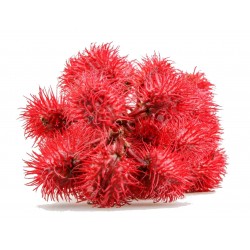
Castor Bean Seeds (Ricinus...
Pret
1,85 €
(SKU: MHS 125)
Seeds Gallery EU,
5/
5
<h2 class=""><strong>Castor Bean Seeds (Ricinus Communis)</strong></h2>
<h2><span style="color: #ff0000;"><strong>Price for Package of 15 seeds.</strong></span></h2>
<p><i style="font-size: 14px;"><b>Ricinus communis</b></i><span style="font-size: 14px;">, the</span><span style="font-size: 14px;"> </span><b style="font-size: 14px;">castor bean</b><span style="font-size: 14px;"> </span><span style="font-size: 14px;">or</span><span style="font-size: 14px;"> </span><b style="font-size: 14px;">castor oil plant</b><span style="font-size: 14px;">,</span><span style="font-size: 14px;"> </span><span style="font-size: 14px;">is a species of</span><span style="font-size: 14px;"> </span><span style="font-size: 14px;">perennial</span><span style="font-size: 14px;"> </span><span style="font-size: 14px;">flowering plant</span><span style="font-size: 14px;"> </span><span style="font-size: 14px;">in the</span><span style="font-size: 14px;"> </span><span style="font-size: 14px;">spurge</span><span style="font-size: 14px;"> </span><span style="font-size: 14px;">family,</span><span style="font-size: 14px;"> </span><span style="font-size: 14px;">Euphorbiaceae</span><span style="font-size: 14px;">. It is the sole species in the</span><span style="font-size: 14px;"> </span><span style="font-size: 14px;">monotypic</span><span style="font-size: 14px;">genus</span><span style="font-size: 14px;">,</span><span style="font-size: 14px;"> </span><i style="font-size: 14px;"><b>Ricinus</b></i><span style="font-size: 14px;">, and</span><span style="font-size: 14px;"> </span><span style="font-size: 14px;">subtribe</span><span style="font-size: 14px;">,</span><span style="font-size: 14px;"> </span><b style="font-size: 14px;">Ricininae</b><span style="font-size: 14px;">. The evolution of castor and its relation to other species are currently being studied using modern genetic tools.</span><span style="font-size: 14px;"> </span><span style="font-size: 14px;">It reproduces with a mixed pollination system which favors selfing by</span><span style="font-size: 14px;"> </span><span style="font-size: 14px;">geitonogamy</span><span style="font-size: 14px;"> </span><span style="font-size: 14px;">but at the same time can be an out-crosser by</span><span style="font-size: 14px;"> </span><span style="font-size: 14px;">anemophily</span><span style="font-size: 14px;"> </span><span style="font-size: 14px;">(wind pollination) or</span><span style="font-size: 14px;"> </span><span style="font-size: 14px;">entomophily</span><span style="font-size: 14px;"> </span><span style="font-size: 14px;">(insect pollination).</span></p>
<div>
<p>Its<span> </span>seed<span> </span>is the castor bean, which, despite its name, is not a true<span> </span>bean. Castor is indigenous to the southeastern<span> </span>Mediterranean Basin,<span> </span>Eastern Africa, and India, but is widespread throughout tropical regions (and widely grown elsewhere as an ornamental plant).<sup id="cite_ref-Phillips_5-0" class="reference">[5]</sup></p>
<p>Castor seed is the source of<span> </span>castor oil, which has a wide variety of uses. The seeds contain between 40% and 60% oil that is rich in<span> </span>triglycerides, mainly<span> </span>ricinolein. The<span> </span>seed<span> </span>also contains<span> </span>ricin, a<span> </span>water-soluble<span> </span>toxin, which is also present in lower concentrations throughout the plant.</p>
<p>An unrelated plant species,<span> </span><i>Fatsia japonica</i><span> </span>(false castor oil plant), is similar in appearance but is from Japan.</p>
<h2><span class="mw-headline" id="Nomenclature">Nomenclature</span></h2>
<p>The name<span> </span><i>Ricinus</i><span> </span>is a<span> </span>Latin<span> </span>word for<span> </span>tick; the seed is so named because it has markings and a bump at the end that resemble certain ticks. The genus<span> </span><i>Ricinus</i><span> </span><sup id="cite_ref-6" class="reference">[6]</sup><span> </span>also exists in zoology, and designates insects (not ticks) which are parasites of birds; this is possible because the names of animals and plants are governed by different<span> </span>nomenclature codes.<sup class="noprint Inline-Template Template-Fact">[<i><span title="This claim needs references to reliable sources. (October 2017)">citation needed</span></i>]</sup></p>
<p>The common name "castor oil" probably comes from its use as a replacement for<span> </span>castoreum, a perfume base made from the dried<span> </span>perineal glands<span> </span>of the<span> </span>beaver<span> </span>(<i>castor</i><span> </span>in Latin).<sup id="cite_ref-7" class="reference">[7]</sup>It has another common name,<span> </span><b>palm of Christ</b>, or<span> </span><i>Palma Christi</i>, that derives from castor oil's reputed ability to heal wounds and cure ailments.</p>
<h2><span class="mw-headline" id="Description">Description</span></h2>
<p><i>Ricinus communis</i><span> </span>can vary greatly in its growth habit and appearance. The variability has been increased by breeders who have selected a range of cultivars for leaf and flower colours, and for oil production. It is a fast-growing,<span> </span>suckering<span> </span>shrub<span> </span>that can reach the size of a small tree, around 12 m (39 ft), but it is not<span> </span>cold hardy.</p>
<p>The glossy<span> </span>leaves<span> </span>are 15–45 cm (5.9–17.7 in) long, long-stalked, alternate and palmate with five to twelve deep lobes with coarsely toothed segments. In some varieties they start off dark reddish purple or bronze when young, gradually changing to a dark green, sometimes with a reddish tinge, as they mature. The leaves of some other varieties are green practically from the start, whereas in yet others a pigment masks the green color of all the<span> </span>chlorophyll-bearing parts, leaves, stems and young fruit, so that they remain a dramatic purple-to-reddish-brown throughout the life of the plant. Plants with the dark leaves can be found growing next to those with green leaves, so there is most likely only a single gene controlling the production of the pigment in some varieties.<sup id="cite_ref-8" class="reference">[8]</sup><span> </span>The stems and the spherical, spiny seed capsules also vary in pigmentation. The fruit capsules of some varieties are more showy than the flowers.</p>
<div class="thumb tright">
<div class="thumbinner"><img alt="" src="https://upload.wikimedia.org/wikipedia/commons/thumb/2/23/Castor_oil_plant_seeds.jpg/220px-Castor_oil_plant_seeds.jpg" width="220" height="129" class="thumbimage" />
<div class="thumbcaption">
<div class="magnify"></div>
The green capsule dries and splits into three sections, forcibly ejecting seeds</div>
</div>
</div>
<p>The flowers lack petals and are unisexual (male and female) where both types are borne on the same plant (monoecious) in terminal<span> </span>panicle-like<span> </span>inflorescences<span> </span>of green or, in some varieties, shades of red. The male flowers are numerous, yellowish-green with prominent creamy<span> </span>stamens; the female flowers, borne at the tips of the spikes, lie within the immature spiny capsules, are relatively few in number and have prominent red<span> </span>stigmas.<sup id="cite_ref-Brickell_9-0" class="reference">[9]</sup></p>
<p>The fruit is a spiny, greenish (to reddish-purple)<span> </span>capsule<span> </span>containing large, oval, shiny, bean-like, highly poisonous seeds with variable brownish mottling. Castor seeds have a warty appendage called the<span> </span>caruncle, which is a type of<span> </span>elaiosome. The caruncle promotes the dispersal of the seed by ants (myrmecochory).</p>
<h2><span class="mw-headline" id="Medicinal_uses">Medicinal uses</span></h2>
<p>Castor oil<span> </span>has many uses in medicine and other applications.</p>
<p>An alcoholic extract of the leaf was shown, in lab rats, to protect the liver from damage from certain poisons.<sup id="cite_ref-10" class="reference">[10]</sup><sup id="cite_ref-11" class="reference">[11]</sup><sup id="cite_ref-12" class="reference">[12]</sup><span> </span>Methanolic<span> </span>extracts of the leaves of<span> </span><i>Ricinus communis</i><span> </span>were used in<span> </span>antimicrobial<span> </span>testing against eight pathogenic bacteria in rats and showed antimicrobial properties. The<span> </span>pericarp<span> </span>of<span> </span><i>Ricinus</i><span> </span>showed central nervous system effects in mice at low doses. At high doses mice quickly died.<sup id="cite_ref-Williamson02_13-0" class="reference">[13]</sup><span> </span>A water extract of the root bark showed analgesic activity in rats.<sup id="cite_ref-Williamson02_13-1" class="reference">[13]</sup><span> </span>Antihistamine and anti-inflammatory properties were found in ethanolic extract of<span> </span><i>Ricinus communis</i><span> </span>root bark.<sup id="cite_ref-14" class="reference">[14]</sup></p>
<h2><span class="mw-headline" id="Other_uses">Other uses</span></h2>
<p>Extract of<span> </span><i>Ricinus communis</i><span> </span>exhibited<span> </span>acaricidal<span> </span>and<span> </span>insecticidal<span> </span>activities against the adult of<span> </span><i>Haemaphysalis bispinosa</i><span> </span>Neumann (Acarina:<span> </span>Ixodidae) and<span> </span>hematophagous<span> </span>fly<span> </span><i>Hippobosca maculata</i><span> </span>Leach (Diptera:<span> </span>Hippoboscidae).<sup id="cite_ref-15" class="reference">[15]</sup></p>
<p>The Bodo tribals of<span> </span>Bodoland<span> </span>in Assam, India, use the leaves of this plant to feed and rear the<span> </span>larvae<span> </span>of<span> </span>muga<span> </span>and<span> </span>endi<span> </span>silkworms.</p>
<p>Castor oil is an effective motor lubricant and has been used in<span> </span>internal combustion engines, including those of<span> </span>World War I<span> </span>airplanes, some racing cars and some<span> </span>model airplanes. It has historically been popular for lubricating<span> </span>two-stroke engines<span> </span>due to high resistance to heat compared to petroleum-based oils. It does not mix well with petroleum products, particularly at low temperatures, but mixes better with the methanol based fuels used in<span> </span>glow model engines. In<span> </span>total-loss-lubrication<span> </span>applications, it tends to leave carbon deposits and varnish within the engine. It has been largely replaced by synthetic oils that are more stable and less toxic.</p>
<p>Jewelry is often made of castor beans, particularly necklaces and bracelets.<sup id="cite_ref-16" class="reference">[16]</sup></p>
<h2><span id="Habitat.2C_growth_and_horticultural_uses"></span><span class="mw-headline">Habitat, growth and horticultural uses</span></h2>
<div class="thumb tright">
<div class="thumbinner"><img alt="" src="https://upload.wikimedia.org/wikipedia/commons/thumb/c/cf/Ricinus_communis4.jpg/220px-Ricinus_communis4.jpg" width="220" height="328" class="thumbimage" />
<div class="thumbcaption">
<div class="magnify"></div>
In Greece it is hardy enough to grow as a small tree. In northern countries it is grown instead as an<span> </span>annual.</div>
</div>
</div>
<div class="thumb tright">
<div class="thumbinner"><img alt="" src="https://upload.wikimedia.org/wikipedia/commons/thumb/0/0b/Castor_bean_young_with_teething_leaves.jpg/220px-Castor_bean_young_with_teething_leaves.jpg" width="220" height="146" class="thumbimage" />
<div class="thumbcaption">
<div class="magnify"></div>
Cotyledons<span> </span>(round) and first true leaves (serrated) on a young plant. This plant is about four weeks old.</div>
</div>
</div>
<div class="thumb tright">
<div class="thumbinner"><img alt="" src="https://upload.wikimedia.org/wikipedia/commons/thumb/c/c2/Ricin_commun.jpg/220px-Ricin_commun.jpg" width="220" height="249" class="thumbimage" />
<div class="thumbcaption">
<div class="magnify"></div>
young plant</div>
</div>
</div>
<p>Although<span> </span><i>Ricinus communis</i><span> </span>is indigenous to the southeastern<span> </span>Mediterranean Basin,<span> </span>Eastern Africa, and India, today it is widespread throughout tropical regions.<sup id="cite_ref-Phillips_5-1" class="reference">[5]</sup><span> </span>In areas with a suitable climate, castor establishes itself easily where it can become an invasive plant and can often be found on wasteland.</p>
<p>It is also used extensively as a decorative plant in parks and other public areas, particularly as a "dot plant" in traditional<span> </span>bedding schemes. If sown early, under glass, and kept at a temperature of around 20 °C (68 °F) until planted out, the castor oil plant can reach a height of 2–3 metres (6.6–9.8 ft) in a year. In areas prone to<span> </span>frost<span> </span>it is usually shorter, and grown as if it were an<span> </span>annual.<sup id="cite_ref-Phillips_5-2" class="reference">[5]</sup><span> </span>However, it can grow well outdoors in cooler climates, at least in southern England, and the leaves do not appear to suffer frost damage in sheltered spots, where it remains evergreen.<sup class="noprint Inline-Template Template-Fact">[<i><span title="This claim needs references to reliable sources. (November 2009)">citation needed</span></i>]</sup><span> </span>It was used in Edwardian times in the parks of Toronto, Ontario, Canada. Although not cultivated there, the plant grows wild in Southern California, notably Griffith Park in Los Angeles.<sup id="cite_ref-17" class="reference">[17]</sup></p>
<h3><span class="mw-headline" id="Cultivars">Cultivars</span></h3>
<div class="thumb tright">
<div class="thumbinner"><img alt="" src="https://upload.wikimedia.org/wikipedia/commons/thumb/c/c7/Leaf_of_Castor_bean_plant.jpg/220px-Leaf_of_Castor_bean_plant.jpg" width="220" height="165" class="thumbimage" />
<div class="thumbcaption">
<div class="magnify"></div>
Leaf</div>
</div>
</div>
<p>Selections have been made by breeders for use as ornamental plants (heights refer to plants grown as annuals) and for commercial production of castor oil.<sup id="cite_ref-Brickell_9-1" class="reference">[9]</sup></p>
<dl>
<dt>Ornamental cultivars</dt>
</dl>
<ul>
<li>'Carmencita' has gained the<span> </span>Royal Horticultural Society's<span> </span>Award of Garden Merit<sup id="cite_ref-RHSPF_18-0" class="reference">[18]</sup><sup id="cite_ref-19" class="reference">[19]</sup></li>
<li>'Carmencita Bright Red' has red stems, dark purplish leaves and red seed pods;</li>
<li>'Carmencita Pink' has green leaves and pink seed pods</li>
<li>'Gibsonii' has red-tinged leaves with reddish veins and bright scarlet seed pods</li>
<li>'New Zealand Purple' has plum colored leaves tinged with red, plum colored seed pods turn to red as they ripen
<dl>
<dd>(All the above grow to around 1.5 metres (4.9 ft) tall as annuals.)<sup id="cite_ref-Phillips_5-3" class="reference">[5]</sup></dd>
</dl>
</li>
<li>'Impala' is compact (only 1.2 metres or 3.9 feet tall) with reddish foliage and stems, brightest on the young shoots</li>
<li>'Red Spire' is tall (2–3 metres or 6.6–9.8 feet) with red stems and bronze foliage</li>
<li>'Zanzibarensis' is also tall (2–3 metres or 6.6–9.8 feet), with large, mid-green leaves (50 centimetres or 20 inches long) that have white midribs<sup id="cite_ref-Brickell_9-2" class="reference">[9]</sup></li>
</ul>
<p>Cultivars for oil production:</p>
<ul>
<li>'Hale' was launched in the 1970s for the State of Texas.<sup id="cite_ref-20" class="reference">[20]</sup><span> </span>It is short (up to 1.2 m or 3 ft 11 in) and has several racemes</li>
<li>'Brigham' is a variety with reduced ricin content adapted for Texas. It grows up to 1.8 m (5 ft 11 in) and has 10% of the ricin content of 'Hale'</li>
<li>'BRS Nordestina' was developed by Brazil's<span> </span>Embrapa<span> </span>in 1990 for hand harvest and semi-arid environments</li>
<li>'BRS Energia" was developed by Embrapa in 2004 for mechanised or hand harvest</li>
<li>'GCH6' was developed by<span> </span>Sardarkrushinagar Dantiwada University, India, 2004: it is resistant to root rot and tolerant to<span> </span>fusarium wilt</li>
<li>'GCH5' was developed by Sardarkrushinagar Dantiwada University, 1995. It is resistant to fusarium wilt</li>
<li>'Abaro' was developed by the<span> </span>Ethiopian Institute of Agricultural Research's Essential Oils Research Center for hand harvest</li>
<li>'Hiruy' was developed by the Ethiopian Institute of Agricultural Research's<span> </span>Melkassa<span> </span>and<span> </span>Wondo Genet<span> </span>Agricultural Research Centers for hand harvest during 2010/2011</li>
</ul>
<h2><span class="mw-headline" id="Plant-animal_interactions">Plant-animal interactions</span></h2>
<p><i>Ricinus communis</i><span> </span>is the host plant of the common castor butterfly (<i>Ariadne merione</i>), the eri silkmoth (<i>Samia cynthia ricini</i>), and the castor semi-looper moth (<i>Achaea janata</i>). It is also used as a food plant by the<span> </span>larvae<span> </span>of some other species of<span> </span>Lepidoptera, including<span> </span><i>Hypercompe hambletoni</i><span> </span>and the nutmeg (<i>Discestra trifolii</i>).</p>
<h2><span class="mw-headline" id="Allergenic_potential">Allergenic potential</span></h2>
<p><i>Ricinus</i><span> </span>is extremely allergenic, and has an<span> </span>OPALS<span> </span>allergy scale rating of 10 out of 10. The plant is also a very strong trigger for asthma, and allergies to<span> </span><i>Ricinus</i><span> </span>are commonplace and severe.<sup id="cite_ref-Ogren_21-0" class="reference">[21]</sup></p>
<p>The castor oil plant produces abundant amounts of very light pollen, which easily become airborne and can be inhaled into the lungs, triggering allergic reactions. The sap of the plant causes skin rashes. Individuals who are allergic to the plant can also develop rashes from merely touching the leaves, flowers, or seeds. These individuals can also have cross-allergic reactions to<span> </span>latex<span> </span>sap from the related<span> </span><i>Hevea brasiliensis</i><span> </span>plant.<sup id="cite_ref-Ogren_21-1" class="reference">[21]</sup></p>
<h2><span class="mw-headline" id="Toxicity">Toxicity</span></h2>
<div class="thumb tright">
<div class="thumbinner"><img alt="" src="https://upload.wikimedia.org/wikipedia/commons/thumb/b/bd/Seeds_of_Ricinus_communis.jpg/220px-Seeds_of_Ricinus_communis.jpg" width="220" height="220" class="thumbimage" />
<div class="thumbcaption">
<div class="magnify"></div>
Seeds</div>
</div>
</div>
<div class="hatnote navigation-not-searchable">Main article:<span> </span>Ricin</div>
<p>The toxicity of raw castor beans is due to the presence of<span> </span>ricin. Although the lethal dose in adults is considered to be four to eight seeds, reports of actual poisoning are relatively rare.<sup id="cite_ref-22" class="reference">[22]</sup><span> </span>According to the<span> </span><i>Guinness World Records</i>, this is the world's most poisonous common plant.<sup id="cite_ref-23" class="reference">[23]</sup><span> </span>Symptoms of overdosing on ricin, which can include<span> </span>nausea,<span> </span>diarrhea,<span> </span>tachycardia,<span> </span>hypotension<span> </span>and<span> </span>seizures, persist for up to a week. However, the poison can be extracted from castor by concentrating it with a fairly complicated process similar to that used for extracting<span> </span>cyanide<span> </span>from<span> </span>almonds.</p>
<p>If ricin is ingested, symptoms may be delayed by up to 36 hours but commonly begin within 2–4 hours. These include a burning sensation in mouth and throat, abdominal pain, purging and bloody diarrhea. Within several days there is severe dehydration, a drop in blood pressure and a decrease in urine. Unless treated, death can be expected to occur within 3–5 days; however, in most cases a full recovery can be made.<sup id="cite_ref-Soto-Blanco_24-0" class="reference">[24]</sup><sup id="cite_ref-25" class="reference">[25]</sup></p>
<p>Poisoning occurs when animals, including humans, ingest broken seeds or break the<span> </span>seed<span> </span>by chewing: intact seeds may pass through the digestive tract without releasing the toxin.<sup id="cite_ref-Soto-Blanco_24-1" class="reference">[24]</sup><span> </span>The toxin provides the castor oil plant with some degree of natural protection from insect pests such as<span> </span>aphids. Ricin has been investigated for its potential use as an<span> </span>insecticide.<sup id="cite_ref-Ombrello_26-0" class="reference">[26]</sup><span> </span>The castor oil plant is also the source for<span> </span>undecylenic acid, a natural<span> </span>fungicide.</p>
<p>Commercially available cold-pressed castor oil is not toxic to humans in normal doses, either internal or externally.<sup id="cite_ref-27" class="reference">[27]</sup></p>
<h2><span class="mw-headline" id="Chemistry">Chemistry</span></h2>
<p>Three<span> </span>terpenoids<span> </span>and a<span> </span>tocopherol-related compound have been found in the aerial parts of<span> </span><i>Ricinus</i>. Compounds named (3<i>E</i>,7<i>Z</i>,11<i>E</i>)-19-hydroxycasba-3,7,11-trien-5-one, 6α-hydroxy-10β-methoxy-7α,8α-epoxy-5-oxocasbane-20,10-olide, 15α-hydroxylup-20(29)-en-3-one, and (2<i>R</i>,4a<i>R</i>,8a<i>R</i>)-3,4,4a,8a-tetrahydro-4a-hydroxy-2,6,7,8a-tetramethyl-2-(4,8, 12-trimethyltridecyl)-2<i>H</i>-chromene-5,8-dione were isolated from the methanol extracts of<span> </span><i>Ricinus communis</i><span> </span>by chromatographic methods.<sup id="cite_ref-28" class="reference">[28]</sup><span> </span>Partitioned h-hexane fraction of<span> </span><i>Ricinus</i><span> </span>root methanol extract resulted in enrichment of two triterpenes: lupeol and urs-6-ene-3,16-dione (erandone). Crude methanolic extract, enriched n-hexane fraction and isolates at doses 100 mg/kg p.o. exhibited significant (P < 0.001) anti-inflammatory activity in carrageenan-induced hind paw oedema model.<sup id="cite_ref-29" class="reference">[29]</sup></p>
<h2><span class="mw-headline" id="Modern_commercial_usage">Modern commercial usage</span></h2>
<div class="thumb tleft">
<div class="thumbinner"><img alt="" src="https://upload.wikimedia.org/wikipedia/commons/thumb/0/0a/2006castor_oil_seed.PNG/220px-2006castor_oil_seed.PNG" width="220" height="96" class="thumbimage" />
<div class="thumbcaption">
<div class="magnify"></div>
Seed output in 2006</div>
</div>
</div>
<div class="thumb tright">
<div class="thumbinner"><img alt="" src="https://upload.wikimedia.org/wikipedia/commons/thumb/c/cc/Castor_bean_in_distubred_area.jpg/220px-Castor_bean_in_distubred_area.jpg" width="220" height="165" class="thumbimage" />
<div class="thumbcaption">
<div class="magnify"></div>
Plant in disturbed area</div>
</div>
</div>
<div class="hatnote navigation-not-searchable">Main article:<span> </span>Castor oil</div>
<p>Global castor seed production is around two million tons per year. Leading producing areas are India (with over three-quarters of the global yield), China and Mozambique, and it is widely grown as a crop in Ethiopia. There are several active breeding programmes.</p>
<div></div>
<h3><span class="mw-headline" id="Production">Production</span></h3>
<table border="1" cellpadding="3" cellspacing="0" width="100%" class="wikitable" align="left">
<tbody>
<tr>
<th colspan="5">Top ten castor oil seed producers – 2013</th>
</tr>
<tr>
<th width="25%" bgcolor="#ddddff">Country</th>
<th width="15%" bgcolor="#ddddff">Production (Tonnes)</th>
<th width="10%" bgcolor="#ddddff">Footnote</th>
</tr>
<tr>
<td><span class="flagicon"><img alt="" src="https://upload.wikimedia.org/wikipedia/en/thumb/4/41/Flag_of_India.svg/23px-Flag_of_India.svg.png" width="23" height="15" class="thumbborder" /> </span>India</td>
<td align="right">1,744,000</td>
<td align="right"></td>
</tr>
<tr>
<td><span class="flagicon"><img alt="" src="https://upload.wikimedia.org/wikipedia/commons/thumb/f/fa/Flag_of_the_People%27s_Republic_of_China.svg/23px-Flag_of_the_People%27s_Republic_of_China.svg.png" width="23" height="15" class="thumbborder" /> </span>People's Republic of China</td>
<td align="right">60,000</td>
<td align="right">*</td>
</tr>
<tr>
<td><span class="flagicon"><img alt="" src="https://upload.wikimedia.org/wikipedia/commons/thumb/d/d0/Flag_of_Mozambique.svg/23px-Flag_of_Mozambique.svg.png" width="23" height="15" class="thumbborder" /> </span>Mozambique</td>
<td align="right">60,000</td>
<td align="right">F</td>
</tr>
<tr>
<td><span class="flagicon"><img alt="" src="https://upload.wikimedia.org/wikipedia/commons/thumb/7/71/Flag_of_Ethiopia.svg/23px-Flag_of_Ethiopia.svg.png" width="23" height="12" class="thumbborder" /> </span>Ethiopia</td>
<td align="right">13,000</td>
<td align="right">*</td>
</tr>
<tr>
<td><span class="flagicon"><img alt="" src="https://upload.wikimedia.org/wikipedia/commons/thumb/a/a9/Flag_of_Thailand.svg/23px-Flag_of_Thailand.svg.png" width="23" height="15" class="thumbborder" /> </span>Thailand</td>
<td align="right">12,000</td>
<td align="right">*</td>
</tr>
<tr>
<td><span class="flagicon"><img alt="" src="https://upload.wikimedia.org/wikipedia/en/thumb/0/05/Flag_of_Brazil.svg/22px-Flag_of_Brazil.svg.png" width="22" height="15" class="thumbborder" /> </span>Brazil</td>
<td align="right">11,953</td>
<td align="right"></td>
</tr>
<tr>
<td><span class="flagicon"><img alt="" src="https://upload.wikimedia.org/wikipedia/commons/thumb/2/27/Flag_of_Paraguay.svg/23px-Flag_of_Paraguay.svg.png" width="23" height="13" class="thumbborder" /> </span>Paraguay</td>
<td align="right">11,000</td>
<td align="right">*</td>
</tr>
<tr>
<td><span class="flagicon"><img alt="" src="https://upload.wikimedia.org/wikipedia/commons/thumb/a/af/Flag_of_South_Africa.svg/23px-Flag_of_South_Africa.svg.png" width="23" height="15" class="thumbborder" /> </span>South Africa</td>
<td align="right">6,200</td>
<td align="right">F</td>
</tr>
<tr>
<td><span class="flagicon"><img alt="" src="https://upload.wikimedia.org/wikipedia/commons/thumb/3/32/Flag_of_Pakistan.svg/23px-Flag_of_Pakistan.svg.png" width="23" height="15" class="thumbborder" /> </span>Pakistan</td>
<td align="right">6,000</td>
<td align="right">*</td>
</tr>
<tr>
<td><span class="flagicon"><img alt="" src="https://upload.wikimedia.org/wikipedia/commons/thumb/2/21/Flag_of_Vietnam.svg/23px-Flag_of_Vietnam.svg.png" width="23" height="15" class="thumbborder" /> </span>Vietnam</td>
<td align="right">6,000</td>
<td align="right">*</td>
</tr>
<tr>
<td bgcolor="#cccccc"><span class="flagicon"> </span><b>World</b></td>
<td bgcolor="#cccccc" align="right"><b>1,854,775</b></td>
<td bgcolor="#cccccc" align="right"><b>A</b></td>
</tr>
<tr>
<td colspan="5">No symbol = official figure, F = FAO estimate, * = Unofficial/Semi-official/mirror data, A = Aggregate (may include official, semi-official or estimates);<br />
<p>Source:<span> </span>Food And Agricultural Organization of United Nations: Economic And Social Department: The Statistical Division</p>
</td>
</tr>
</tbody>
</table>
<div></div>
<h3><span class="mw-headline" id="Other_modern_uses">Other modern uses</span></h3>
<ul>
<li>Whether natural, blended, or chemically altered, castor oil still has many uses. For example, it remains of commercial importance as a non-freezing,<span> </span>antimicrobial, pressure-resistant lubricant for special purposes, either of latex or metals, or as a lubricating component of fuels.<sup id="cite_ref-MortierOrszulik2012_30-0" class="reference">[30]</sup></li>
<li>Castor products are sources of various chemical<span> </span>feedstocks.<sup id="cite_ref-31" class="reference">[31]</sup></li>
<li>In Brazil, castor oil (locally known as mamona oil) is a raw material for some varieties of<span> </span>biodiesel.</li>
<li>In rural areas, the abundant seeds are used by children for<span> </span>slingshot<span> </span>balls, as they have the right weight, size, and hardness.</li>
<li>Because castor seeds are attractively patterned, they are popular in low-cost personal adornments, such as non-durable necklaces and bracelets.</li>
<li>Castor oil has long been used on the skin to prevent dryness. Either purified or processed, it still is a component of many cosmetics.</li>
<li>The high percentage of<span> </span>ricinoleic acid<span> </span>residues in castor oil and its derivatives, inhibits many microbes, whether viral, bacterial or fungal. They accordingly are useful components of many ointments and similar preparations.</li>
<li>Castor oil is the major raw material for<span> </span>polyglycerol polyricinoleate, a modifier that improves the flow characteristics of<span> </span>cocoa butter<span> </span>in the manufacture of<span> </span>chocolate bars, and thereby the costs.</li>
<li>Castor oil is used in the USA to repel<span> </span>moles<span> </span>and<span> </span>voles<span> </span>for lawn care.</li>
</ul>
<h2><span class="mw-headline" id="Historical_usage">Historical usage</span></h2>
<p>Castor seeds have been found in<span> </span>Egyptian<span> </span>tombs dating back to 4000 BC; the slow-burning oil was mostly used to fuel lamps.<span> </span>Herodotus<span> </span>and other<span> </span>Greek<span> </span>travellers noted the use of castor seed oil for lighting, body ointments, and improving hair growth and texture.<span> </span>Cleopatra<span> </span>is reputed to have used it to brighten the whites of her eyes. The<span> </span>Ebers Papyrus<span> </span>is an ancient Egyptian medical treatise believed to date from 1552 BC. Translated in 1872, it describes castor oil as a<span> </span>laxative.<sup id="cite_ref-32" class="reference">[32]</sup></p>
<p>The use of castor bean oil (<i>eranda</i>) in India has been documented since 2000 BC in lamps and in local medicine as a laxative,<span> </span>purgative, and<span> </span>cathartic<span> </span>in<span> </span>Unani,<span> </span>Ayurvedic,<span> </span>siddha<span> </span>and other<span> </span>ethnomedical<span> </span>systems. Traditional Ayurvedic and<span> </span>siddha medicine<span> </span>considers castor oil the king of medicinals for curing<span> </span>arthritic diseases. It is regularly given to children orally, for de-worming.<sup class="noprint Inline-Template Template-Fact">[<i><span title="This claim needs references to reliable sources. (April 2013)">citation needed</span></i>]</sup></p>
<p>The ancient Romans had a variety of medicinal/cosmetic uses for both the seeds and the leaves of<span> </span><i>Ricinus communis</i>. The naturalist<span> </span>Pliny the Elder<span> </span>cited the poisonous qualities of the seeds, but mentioned that they could be used to form wicks for oil lamps (possibly if crushed together), and the oil for use as a laxative and lamp oil.<sup id="cite_ref-33" class="reference">[33]</sup><span> </span>He also recommends the use of the leaves as follows:</p>
<blockquote class="templatequote">
<p>"The leaves are applied topically with vinegar for<span> </span>erysipelas, and fresh-gathered, they are used by themselves for diseases of the mamillæ [breasts] and de- fluxions; a decoction of them in wine, with<span> </span>polentaand<span> </span>saffron, is good for inflammations of various kinds. Boiled by themselves, and applied to the face for three successive days, they improve the complexion."<sup id="cite_ref-34" class="reference">[34]</sup></p>
</blockquote>
<p>In<span> </span>Haiti<span> </span>it is called<span> </span><i>maskreti</i>,<sup id="cite_ref-35" class="reference">[35]</sup><span> </span>where the plant is turned into a red oil that is then given to newborns as a<span> </span>purgative<span> </span>to cleanse the insides of their first stools.<sup id="cite_ref-36" class="reference">[36]</sup></p>
<p>Castor seed and its oil have also been used in China for centuries, mainly prescribed in local medicine for internal use or use in dressings.</p>
<p>Castor oil was used as an instrument of coercion by the paramilitary<span> </span>Blackshirts<span> </span>under the regime of<span> </span>Italian<span> </span>dictator<span> </span>Benito Mussolini, as well as by the<span> </span>Spanish Civil Guard<span> </span>in Francoist Spain. Dissidents and regime opponents were forced to ingest the oil in large amounts, triggering severe<span> </span>diarrhea<span> </span>and<span> </span>dehydration, which could ultimately cause death. This punishment method was originally thought of by<span> </span>Gabriele D'Annunzio, the Italian poet and Fascist supporter, during the<span> </span>First World War. (<i>See also:<span> </span>Castor oil's use as a means of intimidation in Fascist Italy</i>)</p>
</div>
<script src="//cdn.public.n1ed.com/G3OMDFLT/widgets.js"></script>
MHS 125 (4.5g)

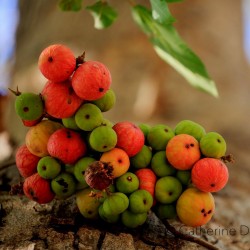
Cluster fig Seeds (Ficus...
Pret
2,10 €
(SKU: V 19 FR)
Seeds Gallery EU,
5/
5
<h2 class=""><strong>Cluster fig Seeds (Ficus racemose)</strong></h2>
<h2><span style="color: #ff0000;"><strong>Price for Package of 10 seeds.</strong></span></h2>
<p>Ficus racemosa (syn. Ficus glomerata Roxb.) is a species of plant in the family Moraceae. Popularly known as the cluster fig tree, Indian fig tree or goolar (gular) fig, this is native to Australia, Malesia, Indo-China, and the Indian subcontinent. It is unusual in that its figs grow on or close to the tree trunk, termed cauliflory. In India, the tree and its fruit are called gular in the north and atti in the south. The fruits are a favourite staple of the common Indian macaque. It serves as a food plant for the caterpillars of the two-brand crow butterfly (Euploea sylvester) of northern Australia.</p>
<p><strong>In Hinduism</strong></p>
<p>In the Atharva Veda, this fig tree (Sanskrit: uḍumbara or udumbara)[2] is given prominence as a means for acquiring prosperity and vanquishing foes.[3] For instance, regarding an amulet of the udumbara tree, a hymn (AV xix,31) extols:</p>
<p>The Lord of amulets art thou, most mighty: in the wealth's</p>
<p>ruler that engendered riches,</p>
<p>These gains are lodged in the, and all great treasures. Amulet,</p>
<p>conquer thou: far from us banish malignity and indigence,</p>
<p>and hunger.</p>
<p>Vigour art thou, in me do thou plant vigour: riches art thou, so</p>
<p>do thou grant me riches.</p>
<p>Plenty art thou, so prosper me with plenty: House-holder, hear</p>
<p>a householder's petition.[4]</p>
<p>It has been described in the story of Raja Harischandra of the Ikshvaku dynasty, that the crown was a branch of this udumbura tree, set in a circlet of gold. Additionally, the throne (simhasana) was constructed out of this wood and the royal personage would ascend it on his knee, chanting to the gods to ascend it with him, which they did so, albeit unseen. Its leaves are an indispensable part of many Hindu havans.</p>
<p><strong>In Buddhism</strong></p>
<p>Both the tree and the flower are referred to as the udumbara (Sanskrit, Pali; Devanagari: उडुम्बर) in Buddhism.[5] Udumbara can also refer to the blue lotus (nila-udumbara, "blue udumbara") flower. The udumbara flower appears in chapters 2 and 27 of the Lotus Sutra, an important Mahayana Buddhist text. The Japanese word udon-ge (優曇華, literally "udon/udumbara flower") was used by Dōgen Zenji to refer to the flower of the udumbara tree in chapter 68 of the Shōbōgenzō ("Treasury of the Eye of the True Dharma"). Dōgen places the udonge in the context of the Flower Sermon given by Gautama Buddha on Vulture Peak. Udonge is also used to refer to the eggs of the lacewing insect. The eggs are laid in a pattern similar to a flower, and its shape is used for divination in Asian fortune telling.</p>
<p>In Theravada Buddhism, the plant is said to have used as the tree for achieved enlightenment (bodhi) by the 26th Lord Buddha, Konaagama (Sinhala: කෝණාගම).</p>
<p><strong>Uses</strong></p>
<p>The Ovambo people call the fruit of the cluster fig eenghwiyu and use it to distill ombike, their traditional liquor.</p>
<p><strong>Health uses</strong></p>
<p>The bark of audumbar (oudumbar) tree is said to have healing power. In countries like India, the bark is rubbed on a stone with water to make a paste, which can be applied over afflicted by boils or mosquito bites. Allow the paste to dry on the skin and reapply after a few hours. For people whose skin is especially sensitive to insect bites, this is a very simple home remedy.</p><script src="//cdn.public.n1ed.com/G3OMDFLT/widgets.js"></script>
V 19 FR (10 S)


Planta Ayurveda

Plantă medicinală sau condimentată
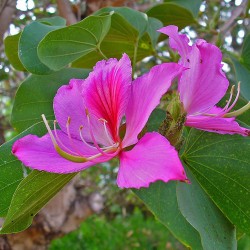
Seminte Mountain Ebony...
Pret
1,25 €
(SKU: T 91)
Seeds Gallery EU,
5/
5
<h2 class=""><strong>Seminte Mountain Ebony (Bauhinia variegata)</strong></h2>
<h2><span style="color: #f80000;" class=""><strong>Preț pentru pachetul de 5 semințe.</strong></span></h2>
Acest senzational copac orhidee alb, in limba engleza se mai numeste si “ Buddhist Orchid” creste pana ajunge un arbust compact sau de diminsiunile unui arbore mic cu coroane expansive, acest copac are frunzele in forma de picior de camila.<br><br>In natura planta este de 10-12 metri, in ghivece insa, se poate tine usor sub control. Din Ianuarie pana in Mai se pot observa gramezi de flori albe cu latimea de aproximativ 12 cm. Uneori acest lucru apare chiar si in timpul verii. Florile emana un miros usor, placut.<br><br>Cum este germinat?<br>Uşor. Semănați semințele, pe care le-ați păstrat în apă proaspătă la temperatura camerei timp de 24 de ore, în vase umplute cu tof, de 3 ori mai adânci decât semințele și udați-le. Așteptați să germineze, menținând solul umed într-un mediu cald, fără soare direct, până când germinarea are loc. În condițiile potrivite, germinarea va avea loc cu siguranță în 21-30 de zile. Temperatura de germinare este cuprinsă între 18-22 de grade. Evitați temperaturile mai ridicate sau mai scăzute.<br><br>* Efectuarea unei mici găuri în cochilie făcând o crestătură pe o parte a semințelor, astfel încât sămânța să poată absorbi ușor apa în timp ce așteaptă în apă, face lucrurile mai rapide și mai ușoare.<br><br>Îngrijire și alte informații<br>Se poate adapta cu ușurință la multe tipuri de sol. Este plantat de la plin soare la semi-umbră în funcție de regiune. Poate crește în soluri argiloase și calcaroase. Se dezvoltă în soluri cu un pH apropiat de neutru, care se transformă din acid în alcalin, ideal la 6-8 Ph.<br><br>Unde este cultivat?<br>Plantă în aer liber, tolerantă la îngheț. Potrivit pentru aplicații de bonsai. Prezintă o creștere moderată.
<script src="//cdn.public.n1ed.com/G3OMDFLT/widgets.js"></script>
T 91 (5 S)


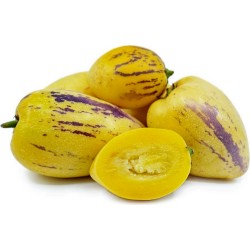
Pepino Dulce, Melon Pear...
Pret
2,95 €
(SKU: V 59)
Seeds Gallery EU,
5/
5
<h2><span style="font-size: 14pt;" class=""><strong>Pepino Dulce, Melon Pear Seeds (Solanum muricatum)</strong></span></h2>
<h3><span style="color: #ff0000; font-size: 14pt;"><strong>Price for Package of 5 seeds.</strong></span></h3>
<p>Solanum muricatum is a species of evergreen shrub native to South America and grown for its sweet edible fruit.</p>
<p>It is known as pepino dulce ("sweet pepino") or simply pepino; the latter is also used for similar species such as "S. mucronatum" (which actually seems to belong in the related genus Lycianthes). The pepino dulce fruit resembles a melon (Cucumis melo) in color, and its flavor recalls a succulent mixture of honeydew and cucumber, and thus it is also sometimes called pepino melon or melon pear, but pepinos are only very distantly related to melons and pears. Another common name, "tree melon", is more often used for the Papaya (Carica papaya) and the pepino dulce plant does generally not look much like a tree. The present species is, however, a close relative of other nightshades cultivated for their fruit, including the tomato (S. lycopersicum) and the eggplant (S. melongena), which its own fruit closely resembles.</p>
<p>The fruit is common in markets in Colombia, Ecuador, Bolivia, Peru and Chile, but less often overseas because it is quite sensitive to handling and does not travel well. Attempts to produce commercial cultivars and to export the fruit have been made in New Zealand, Turkey and Chile.</p>
<p><strong>Distribution and habitat</strong></p>
<p>The pepino dulce is presumed to be native to the temperate Andean regions of Colombia, Peru and Chile, though it is not known in the wild and the details of its domestication are unknown.Thepepino is a domesticated native of the Andes.</p>
<p><strong>Cultivation</strong></p>
<p>Moche clay vessel with pepino decoration (Larco Museum)</p>
<p>Pepinos are not often found archaeologically as they are soft and pulpy and not easy to preserve, while their tough seeds are small and easily lost among debris. But they were already described by early Spanish chroniclers as being cultivated on the coast; the Moche Valley in Peru was particularly famous for them. They were a popular decorative motif in Moche art.</p>
<p>In the United States the fruit is known to have been grown in San Diego before 1889 and in Santa Barbara by 1897. More commercially viable cultivars were introduced from New Zealand and elsewhere towards the end of the 20th century, leading to its introduction into up-scale markets in Japan, Europe and North America.</p>
<p>The pepino dulce is relatively hardy. In its native range it grows at altitudes ranging from close to sea level up to 3,000 m (10,000 ft.). However, it performs best in a warm, relatively frost-free climate. The plant can survive a low temperature of -2.5°C (27 to 28°F) if the freeze is not prolonged, though it may drop many of its leaves.[2] The species is a perennial, but its sensitivity to chilling, pests, and diseases force the growers to replant the crop every year. The crop also adapts well to greenhouse cultivation, training the plants up to 2 m tall, and obtaining yields that are 2-3 times larger than those obtained outdoors.</p>
<p>They are propagated by cuttings since they are established easily without rooting hormones. It is grown in a manner similar to its relatives such as the tomato, though it grows naturally upright by habit and can thus be cultivated as a free-standing bush, though it is sometimes pruned on trellises. Additionally, supports are sometimes used to keep the weight of the fruit from pulling the plant down. It has a fast growth rate and bears fruit within 4 to 6 months after planting. It is a perennial, but is usually cultivated as an annual. Seedlings are intolerant of weeds, but it can later easily compete with low growing weeds. Like their relatives tomatoes, eggplants, tomatillos and tamarillos, pepinos are extremely attractive to beetles, aphids, white flies and spider mites. Pepinos are tolerant of most soil types, but require constant moisture for good fruit production. Established bushes show some tolerance to drought stress, but this typically affects yield. The plants are parthenocarpic, meaning it needs no pollination to set fruit, though pollination will encourage fruiting.</p>
<p><strong>Ripe pepinos</strong></p>
<p>The plant is grown primarily in Chile, New Zealand and Western Australia. In Chile, more than 400 hectares are planted in the Longotoma Valley with an increasing proportion of the harvest being exported. Colombia, Peru, and Ecuador also grow the plant, but on a more local scale. Outside of the Andean region, it been grown in various countries of Central America, Morocco, Spain, Israel, and the highlands of Kenya. In the United States several hundred hectares of the fruit are grown on a small scale in Hawaii and California. More commercially viable cultivars have been introduced from New Zealand and elsewhere in more recent times. As a result, the fruit has been introduced into up-scale markets in Japan, Europe and North America and it is slowly becoming less obscure outside of South America. Delicate and mild-flavored, pepinos are often eaten as a fresh snack fruit, though they combine very well with a number of other fruits as well.</p>
<p>The study of the molecular variation of this pepino is of interest for several reasons. Although the seeds of pepino plants are fertile and produce vigorous offspring, this crop is primarily propagated by cuttings (Heiser, 1964; Anderson, 1979; Morley-Bunker, 1983), and as a consequence, its genetic structure could be different from that of seed-propagated crops.</p>
<script src="//cdn.public.n1ed.com/G3OMDFLT/widgets.js"></script>
V 59 5S


Planta rezistenta la frig si inghet
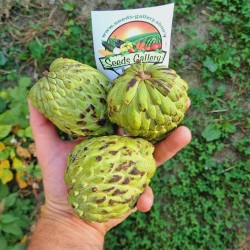
Semințe de Atemoya (Annona...
Pret
5,95 €
(SKU: V 10 AAC)
Seeds Gallery EU,
5/
5
<h2><strong>Semințe de Atemoya (Annona × cherimoya)</strong></h2>
<h2><span style="color: #f80000;"><strong>Preț pentru pachetul de 3 semințe.</strong></span></h2>
Atemoya, Annona × cherimoya sau Annona squamosa × Annona cherimola este un hibrid de două fructe - mărul de zahăr (Annona squamosa) și cherimoya (Annona cherimola) - ambii originari din tropicele americane. Acest fruct este popular în Taiwan, unde este cunoscut sub numele de „măr de zahăr ananas” (鳳梨 釋迦), deci se crede uneori în mod greșit că este o încrucișare între mărul de zahăr și ananasul. În Cuba, este cunoscut sub numele de anón, iar în Venezuela chirimorinon. În Israel și Liban, fructul se numește achta, dar în Israel este mai frecvent să se numească fructul Annona drept latină. În Tanzania se numește stafeli dogo („mini soursop”). În Brazilia, atemoya a devenit populară și în 2011, în Brazilia au fost cultivate aproximativ 1.200 de hectare de atemoia.<br><br>O atemoya este în mod normal în formă de inimă sau rotunjită, cu pielea verde pal, ușor învinețită, cu denivelări. Lângă tulpină, pielea este accidentată, așa cum este în mărul de zahăr, dar devine mai fină ca cherimoya de pe fund. Carnea nu este segmentată ca cea a mărului de zahăr, având mai multă asemănare cu cea a cherimoya. Este foarte suculent și neted, are un gust ușor dulce și puțin tartă, care amintește de o piña colada. Gustul seamănă și cu vanilia de la părintele său de zahăr-măr. [3] Multe semințe negre, necomestibile, toxice se găsesc în toată carnea atemoya. [4] Când sunt coapte, fructele pot fi scoase din coajă și consumate refrigerate.<br><br>Atemoya (Annona cherimola × squamosa) a fost dezvoltată prin încrucișarea cherimoya (A. cherimola) cu zahăr-măr (A. squamosa). Hibrizi naturali au fost găsiți în Venezuela și hibrizi întâmplători au fost observați în pădurile de măr adiacente și cherimoya din Israel în anii 1930 și 1940. [5]<br><br>Prima cruce a fost realizată în 1908 de P.J. Wester, horticultor la Laboratorul Subtropical al USDA din Miami. Fructele rezultate au fost de calitate superioară mărului de zahăr și li s-a dat numele de „atemoya”, o combinație de mâncat, un vechi nume mexican pentru zahăr-măr și „moya” din cherimoya. Ulterior, în 1917, Edward Simmons de la stația de introducere a plantelor din Miami a crescut cu succes hibrizi care au supraviețuit unei scăderi a temperaturii la 26,1 ° F (−3,1 ° C), arătând rezistența atemoya derivată de la unul dintre părinții săi, cherimoya.<br><br>Atemoya, la fel ca alți copaci Annona, poartă flori protogine, hermafrodite, iar auto-polenizarea este rară. Prin urmare, polenizarea artificială a mâinilor garantează aproape întotdeauna fructe de calitate superioară. Un soi, „Geffner”, produce bine fără polenizarea mâinilor. „Bradley” produce, de asemenea, culturi corecte, fără polenizare a mâinilor, dar fructul are obiceiul de a se despica pe copac. [6] Atemoyas sunt uneori deformate, subdezvoltate pe o parte, ca urmare a polenizării inadecvate.<br><br>O floare de atemoya, în stadiul său feminin, se deschide între orele 14:00 și 16:00; între 15:00 și 17:00 în după-amiaza următoare, floarea se transformă în stadiul său masculin.<script src="//cdn.public.n1ed.com/G3OMDFLT/widgets.js"></script>
V 10 AAC (3 S)

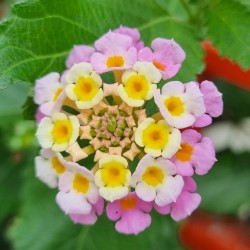
Semințe Lantana camara
Pret
1,95 €
(SKU: MHS 59)
Seeds Gallery EU,
5/
5
<h2 class=""><strong>Semințe Lantana camara</strong><br><span style="color: #f80000;"><strong>Preț pentru pachetul de 10 semințe</strong></span></h2>
<p style="color: #202122; font-size: 14px;">Lantana este interesant pentru florile sale. Ele sunt mici, au o aromă plăcută și astfel colectate umbrele destul de mari. Particularitatea constă în faptul că într-o singură flori inflorescență sunt vopsite în diferite nuanțe. Acele flori care înflorit în primul rând, devenind culorile galben și portocaliu, iar mai târziu au devenit roșu saturat.<br><br>Lantan este crescut din semințe - acesta este cel mai comun mod. Mai departe spre cutia de ocupație nepretențioasă în luna februarie. Pana la suprafața solului nu părea mai bine de temperatura de germinare menținută la 16 ° C - aceasta va dura aproximativ 7-15 zile.<br><br>Lantana din semințe pot fi cultivate și modul comun între fanii de plante de interior. Bace cu semințe sugestii puse într-un termos și se adaugă apă cu o temperatură de 40 ° C Semințele au nevoie de aproximativ susține două până la trei ore. Semințele sunt apoi eliberate din pulpa și boabe de pus în apă pentru o altă zi. Mai departe este posibil să se înceapă plantarea sol fertil cu o bună penetrare a aerului și a apei. Plantat semințele ar trebui să acopere filmul și pus într-un loc cald. Lantana nu cere să aibă grijă, cu condiția ca acesta va fi capabil de a obține cota lor de lumina soarelui. Ea nu se teme de aer uscat, astfel încât nu este nevoie pentru a pulveriza plantele. Udarea ar trebui să fie din belșug, dar fă-o mai bine atunci când solul este uscat com. In lipsa de umiditate lantan poate reacționa Dries inflorescențe și chiar moartea. În timpul iernii, planta nu arata atat de pitoresc. ramuri nu este o întinse mulțime de frunze. Aceste ramuri sunt cel mai bine tăiate. În afară de tundere Bush permite de a forma un compact, urmată de înflorire bună.</p>
<script src="//cdn.public.n1ed.com/G3OMDFLT/widgets.js"></script>
MHS 59 (10 S)


Planta rezistenta la frig si inghet
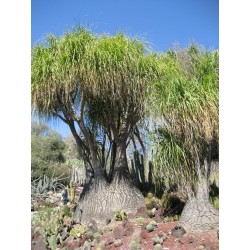
Semințe Picior de elefant...
Pret
1,95 €
(SKU: PS 15)
Seeds Gallery EU,
5/
5
<h2><strong>Semințe Picior de elefant (Beaucarnea recurvata)</strong></h2>
<h2><span style="color: #f80000;"><strong>Preț pentru pachetul de 2 semințe.</strong></span></h2>
<p>Picior de elefant, familie Agavaceae Este originar din regiunile semideşertice de pe teritoriul sud-est al Mexicului, unde poate creşte până la o înălţime de 4-6 m. Trunchiul pe partea de jos s-a îngroşat pentru a menţine apă. Frunzele lungi, tip panglică, de culoare verde-gri, ies de pe vârful tulpinei în cantităţi mari, se înclină spre jos şi spre interior. La noi este o plantă foarte îndrăgită, deoarece îngrijirea ei este foarte uşoară, este foarte decorativă şi elegantă. Se vând în mărimi diferite, iar frunzele înclinate, bogate şi pline sunt deosebit de frumoase şi în faze timpurii. <br><br>Este o plantă care preferă locuri luminoase şi călduroase. Rezistă şi în locuri cu aer uscat. În perioada de creştere, din primavară până în toamnă, necesită irigare regulată. O dată pe lună se poate aplica soluţii nutritive. Este sensibilă la apă statută. Necesită sol cu capacitate bună de drenare. Este o plantă ideală pentru apartamente cu aer uscat. Este de creştere lentă. Vara se poate ţine şi afară, dacă este posibil, în locuri cu semiumbră. Timp de iarnă trebuie udată cu moderaţie. Este o plantă care iernează bine în grădini de iarnă luminoase şi reci sau la scară blocului. Va mulţumi dacă este stropită ocazional cu apă. Temperatură minimă: sensibil la îngheţ. Germinarea seminţelor este uşoară, necesită aprox. 6-8 săptămâni.</p>
<script src="//cdn.public.n1ed.com/G3OMDFLT/widgets.js"></script>
PS 15 (2 S)


Planta rezistenta la frig si inghet
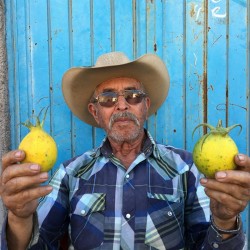
Seminte de jarilla (Jarilla...
Pret
7,95 €
(SKU: V 72)
Seeds Gallery EU,
5/
5
<h2 class=""><strong>Seminte de jarilla (Jarilla caudata)</strong></h2>
<h2><span style="color: #ff0a0a;"><strong>Preț pentru pachetul de 3 semințe.</strong></span></h2>
Jarilla caudata este o plantă destul de puțin spectaculoasă și o rudă de papaya cu fructe destul de extraordinare și extrem de neobișnuite. O perenă verticală sau târâtoare, cu foioase uscate, erbacee, originară din Mexic și America Centrală, unde crește în păduri xerofitice și păduri de foioase, la altitudini cuprinse între 1500 și 2000 m.<br><br>Similar cu Jarilla heterophylla, produce un tubercul suculent care deține tulpini verzi sau verde-purpuriu ramificate de la bază cu frunze ovale până la lanceolate și flori albicioase cu dungi ocazionale de violet. Florile sunt urmate de fructe alungite până la eliptice, care pot ajunge până la 30 cm în lungime, cu proiecții lungi, asemănătoare cornului. Acestea sunt pătate în nuanțe mai deschise și mai întunecate de verde și devin galbene când sunt coapte, în timp ce „coarnele” devin violet.<br><br>Fructele sunt comestibile și se găsesc ocazional pe piețele locale. Fructele moi se consumă crude, în timp ce cele complet mature sunt folosite pentru a face o băutură răcoritoare din sucul lor. Conform unei rețete vechi mexicane, fructele Jarilla caudata pot fi, de asemenea, folosite pentru a face conserve și sunt deosebit de delicioase atunci când sunt combinate cu nucă de cocos.<br><br>Această rudă a papaya va crește bine în majoritatea climelor temperate calde până la cel puțin USDA Zona 9 și chiar va supraviețui secetei și frigului. Ar fi o specie interesantă pentru hibridizare cu alte rude de papaya.
<script src="//cdn.public.n1ed.com/G3OMDFLT/widgets.js"></script>
V 72 (3 S)





